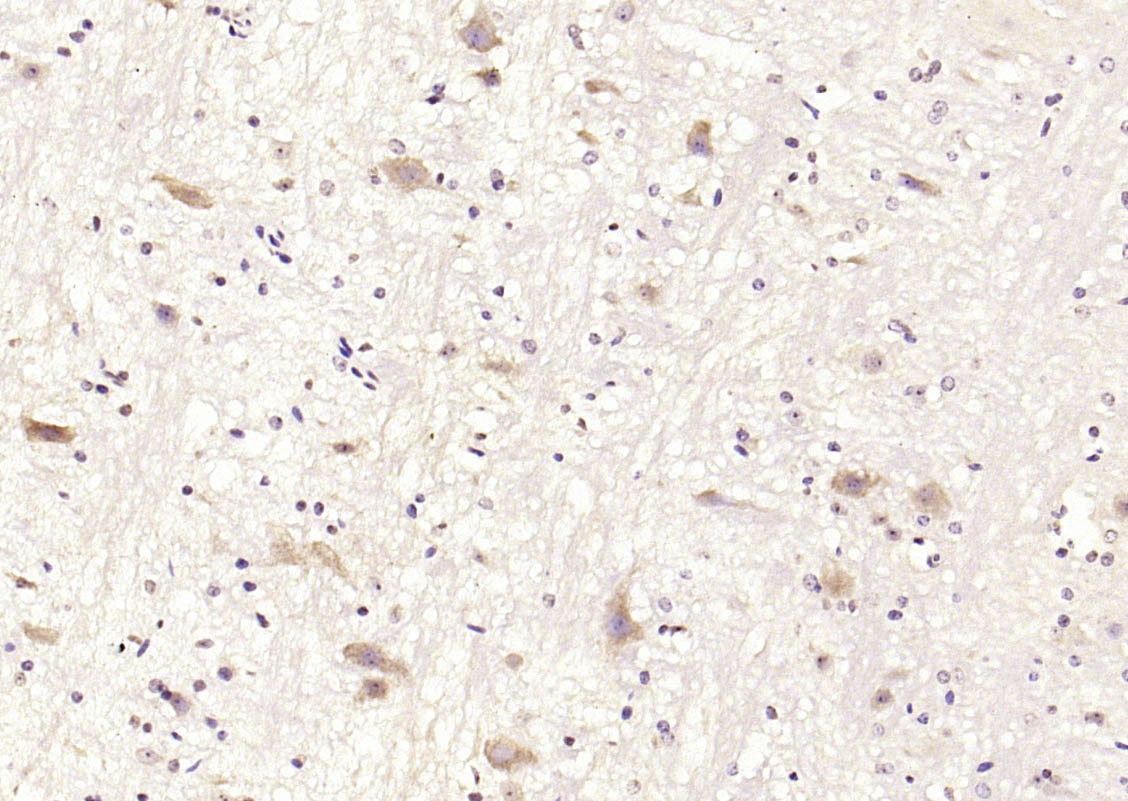
Rabbit Anti-Ankyrin B antibody
ANK-2; Ank2; ANK2_HUMAN; Ankyrin 2; Ankyrin 2 brain; Ankyrin B; Ankyrin nonerythroid; ANKYRIN, NEURONAL; Ankyrin-2; Ankyrin-B; Brain ankyrin; Non-erythroid ankyrin
View History [Clear]
Details
Product Name Ankyrin B Chinese Name 锚定蛋白B抗体 Alias ANK-2; Ank2; ANK2_HUMAN; Ankyrin 2; Ankyrin 2 brain; Ankyrin B; Ankyrin nonerythroid; ANKYRIN, NEURONAL; Ankyrin-2; Ankyrin-B; Brain ankyrin; Non-erythroid ankyrin Research Area immunology Neurobiology Signal transduction Cell adhesion molecule Cytoskeleton Immunogen Species Rabbit Clonality Polyclonal React Species Mouse, (predicted: Human, Rat, Pig, Cow, Horse, ) Applications ELISA=1:5000-10000 IHC-P=1:100-500 (Paraffin sections need antigen repair)
not yet tested in other applications.
optimal dilutions/concentrations should be determined by the end user.Theoretical molecular weight 426kDa Cellular localization cytoplasmic The cell membrane Form Liquid Concentration 1mg/ml immunogen KLH conjugated synthetic peptide derived from human Ankyrin B: 1901-2100/3957 Lsotype IgG Purification affinity purified by Protein A Buffer Solution 0.01M TBS(pH7.4) with 1% BSA, 0.03% Proclin300 and 50% Glycerol. Storage Shipped at 4℃. Store at -20 °C for one year. Avoid repeated freeze/thaw cycles. Attention This product as supplied is intended for research use only, not for use in human, therapeutic or diagnostic applications. PubMed PubMed Product Detail Members of the Ankyrin family of proteins mediate the attachment of integral membrane proteins to the cytoskeleton. ANK1, ANK2 and ANK3 genes encode for the proteins in this family, Ankyrin-1 (also designated Ankyrin R), Ankyrin B and Ankyrin G, respectively. The proteins are structured similarly each composed of an N-terminal domain with multiple ankyrin repeats, a highly conserved central spectrin binding domain, and C-terminal regulatory domains which are susceptible to the most variance. Both Ankyrin B and Ankyrin G are essential for normal neuronal functions. Ankyrin B, or brain Ankyrin is predominantly expressed in the plasma membrane of neurons as well as glial cells throughout the brain. Two transcripts have been described with alternative splicing resulting in additional isoforms. The Ankyrin B protein associates with the spectrin-actin network, mediates axon fasciculation, and stabilizes axon bundles. Ankyrin B is required for coordinated assembly of Na/Ca exchanger, Na/K ATPase, and inositol trisphosphate (InsP(3)) receptor at transverse-tubule/sarcoplasmic reticulum sites in cardiomyocytes.
Function:
Attaches integral membrane proteins to cytoskeletal elements. Also binds to cytoskeletal proteins. Required for coordinate assembly of Na/Ca exchanger, Na/K ATPase and InsP3 receptor at sarcoplasmic reticulum sites in cardiomyocytes. Required for the coordinated expression of the Na/K ATPase, Na/Ca exchanger and beta-2-spectrin (SPTBN1) in the inner segment of rod photoreceptors. Required for expression and targeting of SPTBN1 in neonatal cardiomyocytes and for the regulation of neonatal cardiomyocyte contraction rate.
Subunit:
Interacts with RHBG and SPTBN1.
Subcellular Location:
Cytoplasm, cytoskeleton. Membrane. Cytoplasm, myofibril, sarcomere, M line. Apical cell membrane. Cell membrane.
Tissue Specificity:
Present in plasma membrane of neurons as well as glial cells throughout the brain. Expressed in fetal brain and in temporal cortex of adult brain. Also expressed in the inner segments of rod photoreceptors in retina.
DISEASE:
Defects in ANK2 are the cause of long QT syndrome type 4 (LQT4) [MIM:600919]; also known as sick sinus syndrome with bradycardia. Long QT syndromes are heart disorders characterized by a prolonged QT interval on the ECG and polymorphic ventricular arrhythmias. They cause syncope and sudden death in response to exercise or emotional stress. LQT4 displays many atypical features compared to classical long QT syndromes, including pronounced sinus bradycardia, polyphasic T waves and atrial fibrillation. Cardiac repolarization defects may be not as severe as in classical LQT syndromes and prolonged QT interval on EKG is not a consistent feature.
Similarity:
Contains 24 ANK repeats.
Contains 2 death domains.
Contains 2 ZU5 domains.
SWISS:
Q01484
Gene ID:
287
Database links:
Product Picture
References (0)
No References
Bought notes(bought amounts latest0)
No one bought this product
User Comment(Total0User Comment Num)
- No comment



 +86 571 56623320
+86 571 56623320
 +86 18668110335
+86 18668110335

